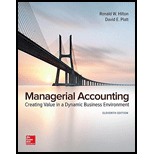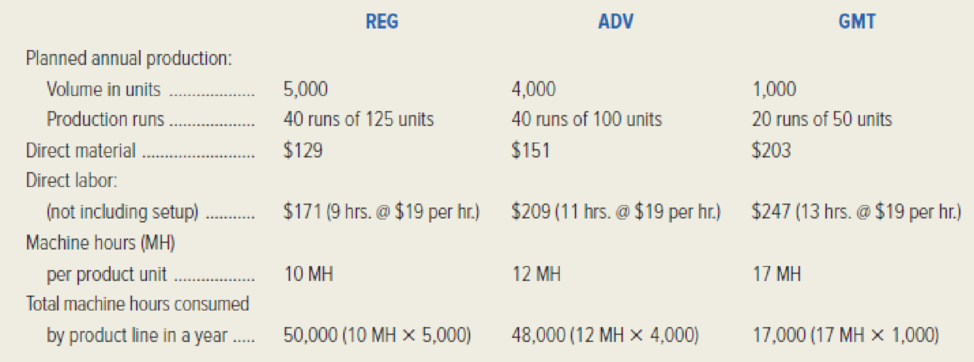
Concept explainers
Kitchen King’s Toledo plant manufactures three product lines, all multi-burner, ceramic cook tops. The plant’s three product models are the Regular (REG), the Advanced (ADV), and the Gourmet (GMT). Until recently, the plant used a

The annual budgeted overhead is $1,224,000, and the company’s predetermined overhead rate is $12 per direct-labor hour. The product costs for the three product models, as reported under the plant’s traditional costing system, are shown in the following table.

Kitchen King’s pricing policy is to set a target price for each product equal to 130 percent of the full product cost. Due to price competition from other appliance manufacturers, REG units were selling at $525, and ADV units were selling for $628. These prices were somewhat below the firm’s target prices. However, these results were partially offset by greater-than-expected profits on the GMT product line. Management had raised the price on the GMT model to $800, which was higher than the original target price. Even at this price. Kitchen King’s customers did not seem to hesitate to place orders. Moreover, the company’s competitors did not mount a challenge in the market for the GMT product line. Nevertheless, concern continued to mount in Toledo about the difficulty in the REG and ADV markets. After all, these were the plant’s bread-and-butter products, with projected annual sales of 5,000 REG units and 4,000 ADV units.
Kitchen King’s director of cost management Angela Ramirez, had been thinking for some time about a refinement in the Toledo plant’s product-costing system. Ramirez wondered if the traditional, volume-based system was providing management with accurate data about product costs. She had read about activity-based costing, and wondered if ABC would be an improvement to the plant’s product-costing system. After some discussion, an ABC proposal was made to the company’s top management, and approval was obtained. The data collected for the new ABC system is displayed in the following table.

Required:
- 1. Show how the company’s overhead rate of $12 per direct-labor hour was calculated.
- 2. Complete an activity-based costing analysis tor Kitchen King’s three product lines. Display the results of your ABC analysis in a table similar to Exhibit 5-7 in the text.
- 3. Prepare a table similar to Exhibit 5-8, which computes the new product cost for each product line under ABC.
- 4. Prepare a table similar to Exhibit 5-9, which compares the overhead cost, total product cost, and target price for each product line under the two alternative costing systems.
- 5. Was each of Kitchen King’s three product lines overcosted or undercosted? By how much per unit?
- 6. Build a spreadsheet: Construct an Excel spreadsheet to solve requirement (2) above. Show how the solution would change if the machine-related cost pool was $621,000, and the facility cost pool was $1,150,000.
Want to see the full answer?
Check out a sample textbook solution
Chapter 5 Solutions
Managerial Accounting: Creating Value in a Dynamic Business Environment
 Cornerstones of Cost Management (Cornerstones Ser...AccountingISBN:9781305970663Author:Don R. Hansen, Maryanne M. MowenPublisher:Cengage Learning
Cornerstones of Cost Management (Cornerstones Ser...AccountingISBN:9781305970663Author:Don R. Hansen, Maryanne M. MowenPublisher:Cengage Learning Principles of Cost AccountingAccountingISBN:9781305087408Author:Edward J. Vanderbeck, Maria R. MitchellPublisher:Cengage Learning
Principles of Cost AccountingAccountingISBN:9781305087408Author:Edward J. Vanderbeck, Maria R. MitchellPublisher:Cengage Learning Managerial AccountingAccountingISBN:9781337912020Author:Carl Warren, Ph.d. Cma William B. TaylerPublisher:South-Western College Pub
Managerial AccountingAccountingISBN:9781337912020Author:Carl Warren, Ph.d. Cma William B. TaylerPublisher:South-Western College Pub Financial And Managerial AccountingAccountingISBN:9781337902663Author:WARREN, Carl S.Publisher:Cengage Learning,
Financial And Managerial AccountingAccountingISBN:9781337902663Author:WARREN, Carl S.Publisher:Cengage Learning,



